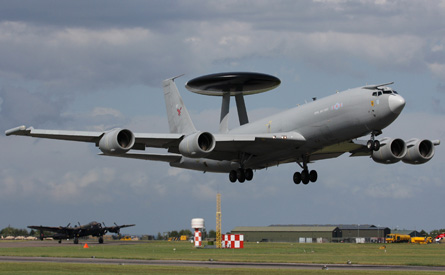The UK Royal Air Force has decided against mothballing two of its seven Boeing E-3D Sentry airborne warning and control system aircraft (AWACS), and will instead look to cut costs and hours flown by reducing the number of aircrews assigned to the type.
According to John Parker, who as whole-life support team director for Northrop Grumman is based at RAF Waddington, Lincolnshire, along with the aircraft, the air force has decided that mothballing aircraft was a more expensive option.
 |
|---|
© Dragon Lady/AirSpace |
Northrop in 2005 was awarded a 20-year, £529 million ($1.06 billion) support and maintenance contract for the E-3D (one pictured above, during last month's Waddington air show), including spares but excluding engines, auxiliary power units and mission software. The availability-based deal is designed to save the RAF £80 million over its course, says Parker, whose team consists of 150 staff.
A mission system upgrade to transform the E-3D - which is based on Boeing's commercial 707-320B - into a hub for UK network-centric warfare capability is meanwhile under consideration by the Ministry of Defence. One proposal, from Boeing Defence UK, is based on Boeing's Block 40/45 upgrade for the US Air Force's 32-strong AWACS fleet.
If advanced, the project would represents the first major upgrade for the E-3D's 1970s-vintage mainframe-based mission system. It would introduce new operator consoles with flat-panel displays, and open-architecture computing using commercial off-the-shelf equipment for lower through-life support costs.
Meanwhile, NATO's military committee on 29 July discussed a request by the alliance's senior commander in Afghanistan to deploy some of its E-3As to manage air traffic movements within the country.
Source: Flight International























